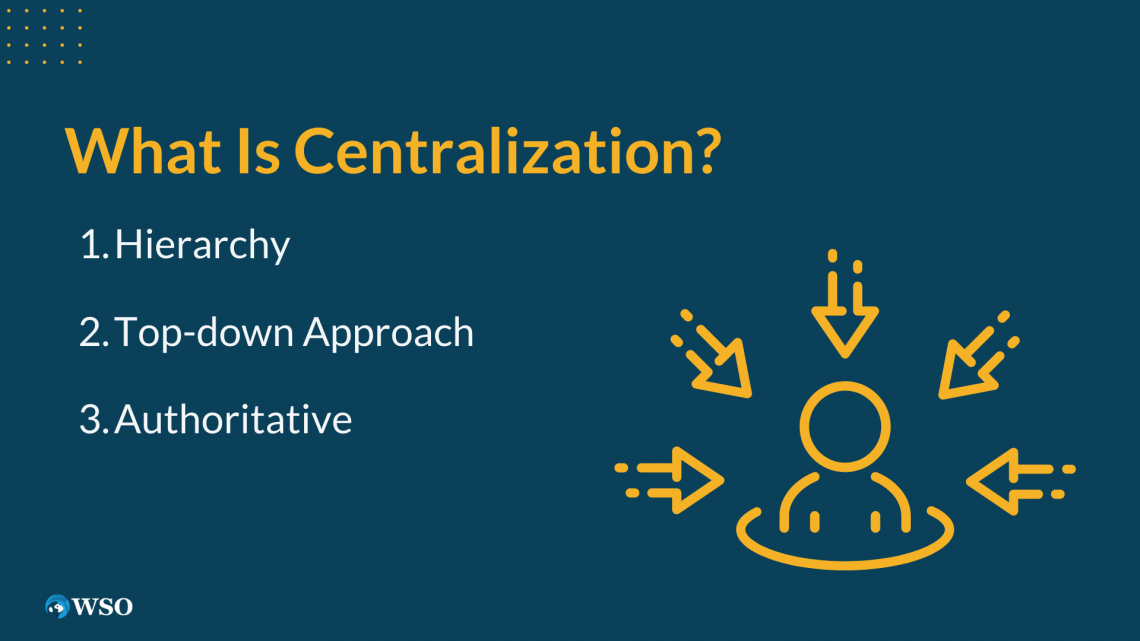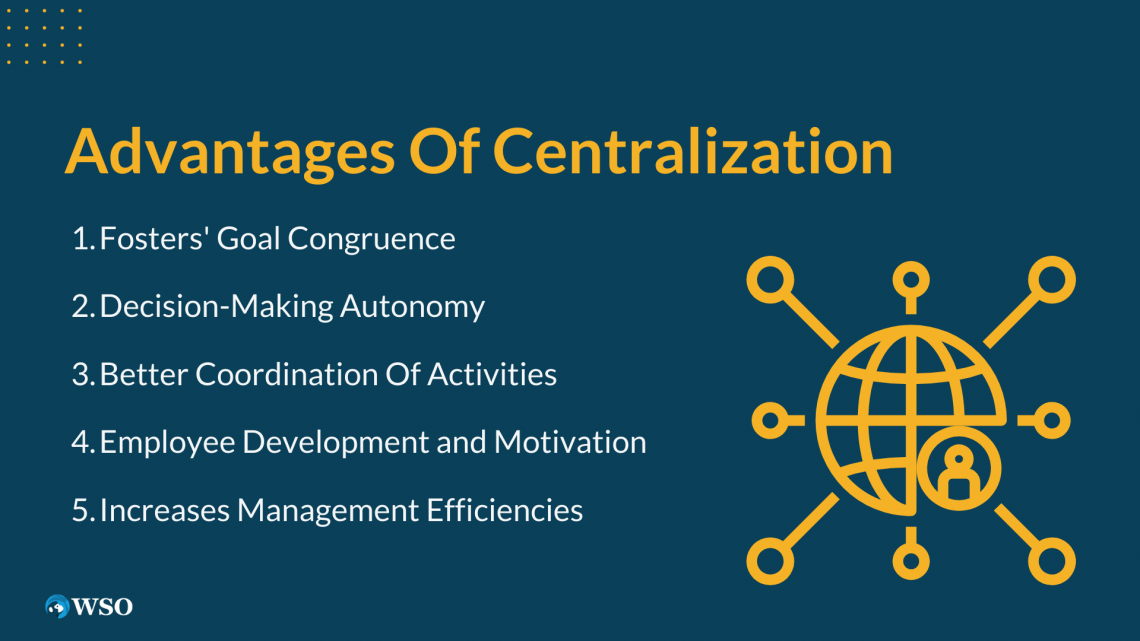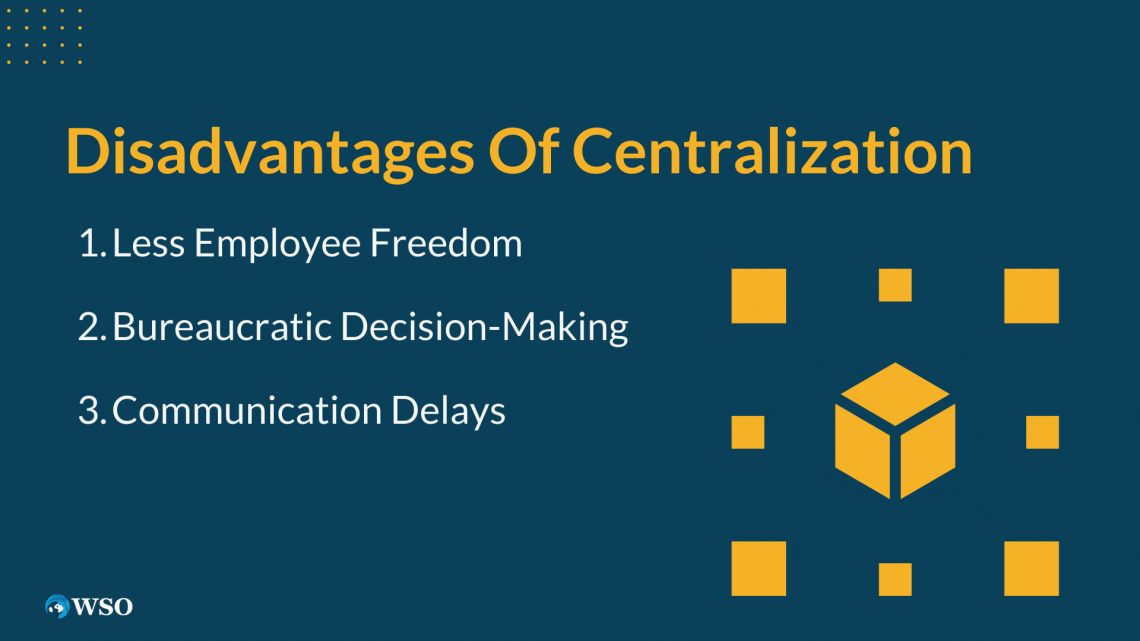Centralization
Centralization is the organizational structure where the power is concentrated at the top-management level.
What Is Centralization?
Centralization is the organizational structure where the power is concentrated at the top management level.

When an organization grows, there comes a thriving need from the owners to control and oversee all the business practices. They also need to understand whether the organization is moving towards achieving its goals.
To this end, the need for an organizational structure to effectively control organizational behavior arose. An organizational structure is a system created within an organization that segregates individual duties and tasks to achieve the overall organization's goal.
Within an organizational structure, the flow of communication is arranged and must be adhered to. The individuals' roles and responsibilities are also assigned based on their capabilities.
In 1776, Adam Smith introduced the idea that the best organizational structure is created based on the division of labor. The division of labor is the segregation of tasks most appropriate to an individual, whereby they can specialize the workflow.

In the division of labor, the employee will be allocated a specific task that matches their capabilities. In this way, when the employee can assuredly complete a job, the efficiency of the organization, as a whole, increases.
The theory introduced by Adam Smith is widely used while creating an organizational structure. After separating the tasks, its systems should have direction and control. This can be done by introducing a centralized structure.
Key Takeaways
- Centralization is the organizational structure where the power is concentrated at the top management level.
- A centralized management style is preferred in smaller companies with small-scale operations.
- Centralization fosters goal congruence and decision-making autonomy, facilitates better coordination, and boosts employee morale.
- Centralization is also a rigid structure that limits communication, creates delayed decisions, and follows a bureaucratic system.
Understanding Centralization
Centralization is an organizational structure where tasks are delegated from the top-level management to the bottom level. Small-scale businesses prefer a vertical communication line with a few employees.

As the organization grows, it is harder to centralize all tasks as the business would have multiple levels of managers in different departments and functional levels.
The highest authority delegates tasks to the other employees in a centralized business structure. This creates an organized communication flow.
Three words best describe centralization - Hierarchy, Top-down approach, and Authoritative.
1. Hierarchy
A crucial aspect of centralization is where the management leaders make the decisions and delegate the tasks to their subordinates. The hierarchy imposed by a centralized organizational structure ranks the management into three levels - top, middle, and bottom.
In a centralized organization, the decisions are made by the top management.
Note
The top management includes the Chief Executive Officer (CEO), the Chief Financial Officer (CFO), or the Chief Information Officer (CIO).
The top-level management must delegate daily tasks. Instead, they structure the organizational activities where the goals are effectively achievable and the strategies are easily implemented. They are the organizational leaders and the first level in its structure.
Following the top managers are the middle managers. These managers are responsible for their divisions which could be:
- IT
- Finance
- Accounting
- Marketing
The middle management does not form strategies but sees that the activities to achieve them are set.
They are responsible for creating daily activities by allocating tasks and resources. Furthermore, they oversee the lower-level employees' duties and whether the tasks are completed. Lastly, they mediate between the top and lower level management.
The lowest level in the organizational hierarchy is the bottom or low-level management. These supervisors oversee whether the tasks delegated by the middle-level management are enforced and report to them for any inefficiencies. They also implement and coordinate activities.
2. Top-down Approach
As the name implies, this approach entails the decisions the top level makes and is passed downwards in the hierarchy. In a centralized organization, all the decisions are made at the top and are implemented by middle and low-level managers.
In this approach, there is a predetermined and specific chain of command. The chain of command is the system by which employees are assigned responsibilities and the manager to whom they report.
The hierarchical positioning of the organizational structure determines the chain of command. The lines of authority are clearly defined when this approach is used.
Note
Top-down Approach is also known as the autocratic leadership policy.
An autocratic leader heads the management and controls all the organization's activities. Their decisions are also not influenced by others' opinions. This management style is preferred in smaller companies with small scaled operations.
The top management behaves as an autocratic leader by segregating the duties based on the employee's caliber, considering the organizational goals. Through this, there is control over the quality of work, and the organization can deliver standardized products and services.
3. Authoritative
In a centralized organization, all decision-making authority is concentrated at the top management level. This way, the senior management is given the authority to form strategies. The lower-level employees must strictly follow their instructions.
The authority then trickles down to middle management, where they can allocate the tasks required to meet the strategies.
Note
It is essential to remember that middle management cannot override the decisions made by the top management.
Even if the middle management believes that a different and innovative approach can be undertaken to meet the tasks, they need the authority to change and influence the decisions of the senior managers.
The low-level managers are designated with the least authority. They are not allowed to override the middle managers' decisions and should ensure that all employees work towards achieving the ultimate goal.
Advantages Of Centralization
Now that we have learned its features let us understand its advantages. Because of these advantages, smaller companies still prefer to work in these structures.

The various benefits of centralization are listed below.
1. Fosters' Goal Congruence
It is when the organizational and management goals coincide. There is usually more clarity between the goals of the organization and the management.
When the management is free to supervise and conduct all business activities, they could get greedy and invest in risky projects that could be beneficial in the short term. This situation arises especially when the management's compensation is linked to profits.
A conflict of interest occurs when management acts like an agent on behalf of the company owners or principals, thus causing the agency problem.
When an organization is centralized, there is a minimal chance that an agency problem could hinder goal congruence. The company's top management assures that the whole organization structure is working towards achieving its goals as they set the strategies.
The task force is presented with activities that can effectively achieve the organization's goals through a focused operation.
Note
When the strategies are implemented based on the organizational vision, it allows for a smoother path toward its achievement.
2. Decision-Making Autonomy
Centralized organizations are known to make quicker decisions. This is significantly assisted by the chain of command created based on the organization structure. When there is a clear flow of communication and commands, it is less likely that there will be any overlap of duties.
The decision-making authority also rests with the top management only, which creates an easier and faster process for approving decisions. Furthermore, the other managers in the hierarchy are not allowed to interfere in the senior management's decisions, speeding up the process.
3. Better Coordination Of Activities
When delegating through a centralized chain of command, there is a very low possibility that the tasks could be duplicated. Every employee is likely given easily achievable tasks contributing to the organization's goals.
Additionally, because there are clear communication lines, it is ensured that there is effective coordination between all departments and levels of management.
Note
Employees are aware of their reporting manager, fostering accountability, and are responsible for their assigned tasks.
4. Employee Development and Motivation
Employees given complex tasks can train themselves to be better leaders and influential decision-makers. When they undertake more tasks through delegation, they prepare themselves to be future managers, thus promoting personal development.
Additionally, when senior managers entrust junior managers with tasks, they believe they can execute the required work accurately. This motivates the employee to complete all tasks effectively with greater self-esteem.
5. Increases Management Efficiencies
Delegation helps improve the management's efficiency as the manager can delegate the smaller tasks to other employees. With this, the manager's workload is reduced, and they can focus on the more significant tasks that require much more extensive attention.
Disadvantages Of Centralization
Listed below are the disadvantages of a centralized business. Due to these, maintaining a centralized structure for larger companies takes time and effort.

1. Less Employee Freedom
Managers at the middle and lower levels are given tasks by their immediate superiors. In this way, the managers cannot make their own decisions. A manager knows best about their department and the factors affecting the sales revenue or profitability.
When decisions, especially regarding budgets, are swapped from the top management, there is a high possibility that the managers will find it challenging to meet the budget cuts.
The top management would create budgets that can achieve effectiveness and efficiency.
However, an employee's performance could be strayed from the budget (portraying underperformance) as they could not correctly estimate the budget factors.
Furthermore, as there is complete control from the top management over every activity, it leaves very little room for innovation and creative thinking.
Note
A manager or employee could not take any new initiatives due to the rigid nature of a centralized organization.
2. Bureaucratic Decision-Making
A centralized organization can be considered bureaucratic as it follows an authoritative hierarchy where the topmost position creates all the decisions. For an organization, the highest authority is the CEO, CIO, and CFO, who creates the steps to achieve strategies.
Middle- and lower-level managers could feel excluded from the decision-making process through this structure. With this, these employees could be demotivated, reflecting their performance.
The most well-known example of a bureaucratic workplace is the military. Working in such a strict environment could cause lower motivation and stress to an employee. It could also significantly affect their loyalty.
3. Communication Delays
When all the decisions require approval from the topmost authority, it could lead to significant delays. This could happen especially when there are multiple office locations, and the communication requires going through the head office.
It could also be possible when numerous subsidiaries there offer for a parent company. Therefore, larger companies are recommended to have a decentralized organizational structure.
Centralization Vs. Decentralization
Now that we have learned what a centralized organization is, let us quickly overview a decentralized structure.

A decentralized organization segregates the decision-making power among different authoritative figures in the organizational structure. Decisions are made at different levels of the organization and are more free-flow than a vertical system introduced by a centralized structure.
Managers and employees are given the freedom to actively participate in making decisions. In a decentralized structure, instead of concentrating the decision-making authority at the top, the power is shared and distributed amongst the various levels, including the lower level.
By creating a decentralized organizational structure, the subordinates, or the lower-level managers, are responsible for their decisions. By granting such a responsibility, the managers would feel confident they will be perceived as capable.
Managers can gain much higher experience and skills through independence. Furthermore, since the managers are not required to seek multiple approvals, there is quicker decision-making power.
Note
A decentralized organization does not necessarily follow a set chain of command. The communication flow is informal and flexible.
A lack of employee motivation and loyalty disadvantaged a centralized organization. However, an employee is given a chance to explore and be innovative in a decentralized structure. Thus, employees generally prefer to work in them.
| Basis | Centralization | Decentralization |
|---|---|---|
| Flow of Command | Vertical; Narrow | Free-flow |
| Decision Making Authority | Concentrated at the top | Shared amongst various levels |
| Communication Flow | Formal | Informal |
| Employee Freedom | Minimal | High |
Many organizations have opted for decentralization. However, complete decentralization is challenging to implement. This applies to achieving an utterly centralized organization as well. Every organization implements both characteristics.
Decentralization suits companies that have a diversified business model. When the decisions are allocated to each business division, they will likely be accurate.
Furthermore, when businesses are located in different countries, it is better to have a decentralized organization to implement decisions quickly. Local managers have better knowledge of the laws and regulations and how to meet customer needs.









or Want to Sign up with your social account?